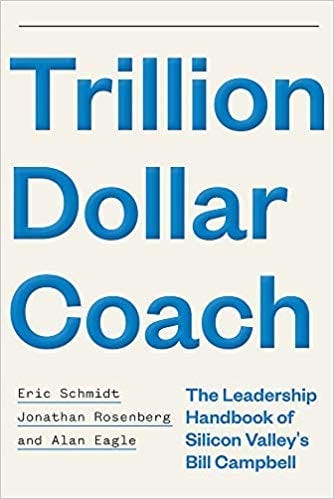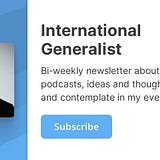What I Took Away From: “Trillion Dollar Coach” by Eric Schmidt, Jonathan Rosenberg and Alan Eagle
As someone who’s constantly splitting time between the startup office and the lacrosse field, I was more than excited when “Trillion…

As someone who’s constantly splitting time between the startup office and the lacrosse field, I was more than excited when “Trillion Dollar Coach” came out. A former American Football coach who then made the switch to Silicon Valley, to make great leaders even better? Sounds like right down my alley.
So I picked up the audiobook. It told the story of Bill Campbell, a former high school and college football coach, who even won the championship with Columbia University once. Bill then moved to California, and slowly got sucked into the Silicon Valley elite, coaching up people like Eric Schmidt (CEO of Google), Steve Jobs (yeah, that guy) and plenty of other leadership personalities. He was also the CEO of several companies, despite having no previous experience in the field.
He seems to have been a great leader, and even better at bringing out leadership in other people. Here’s what I took away:
Be brutally honest, but make sure to let the other person know that you have their best interest in mind.
Today, the ordinary approach to give feedback is the “shit sandwich” approach. You start off with something nice about the person, then deliver your actual message (critical feedback) and then close with something nice again to make the person feel better about themselves.
This doesn’t work. The real message doesn’t come across, because people psychologically tend to be focused on the first and last element of a series. And let’s be honest — if you really want the best for someone, why bother trying to wrap it in something nice if all they need to hear is the truth?
Or, to put it with Bill Campbell’s words: F*** THAT. He would deliver feedback in a brutally honest manner, with colorful language. And the reason he was able to give this kind of feedback is because the people he coached knew that he simply wanted to make them better people. They knew that he cared about them.
And how do you let people know that you care? By listening to them. By paying attention to detail, and showing this, maybe through small gifts. And by hugging them.
Give more hugs.
One thing that stands out in the book is that Bill Campbell would bear-hug anyone who wouldn’t run away from him. Hugging creates psychological safety — it gives the other person the feeling of being welcome, being cared for.
Think about it: when was the last time someone gave you a real good, strong hug (not that weak-ass cheek to cheek stuff that French people do)? And how did that make you feel? Maybe a bit awkward, but probably also really good.
I tend to hug people very strongly, too. The feedback I get: “holy shit that’s a strong hug”. Well, thanks! That’s how it’s supposed to be. If you’re American, you know what I’m talking about; if you’re from Europe — give it a shot sometime. It feels nice.
Create and foster communities, and make memories with them.
One of the most important aspects for Bill in the book was the creation of communities, and the subsequent creation of experiences for them. Two examples stand out:
Every year, Bill would host his annual Super Bowl trip, for which he’d buy plenty of tickets for all his friends and their families, as well as book flights and hotels for them, and pick up the bar tab. Thus, he would ensure that all his friends get together at least once a year to have a memorable experience together.
Another example: when Bill headed to his local sports bar one day, he learned that one of the guests just had graduated from college. In order to make the party a little bit more exciting (and to create an experience), he told the bartender that all the bud lights would be on him that evening. Needless to say, it was a raucous party with lots of memories (or memories lost …).
Now, you may not have the connections or financial funds to do these things, but you can still create communities and experiences for them. Host a dinner, or host a party, or invite people to come along on a trip with you. That’s how you meet new people, make new friends and foster relationships. It makes people feel warm and welcome, and will create these serendipitous events that could change lives forever.
In my experience, hosting parties at my place was the best way to create memories for my group of friends — we still talk about them sometimes, although I haven’t hosted one in over a year. So go ahead and try it — start small and then invite people out to bigger things. You won’t regret it!
Quick aside: one of my life goals is to have an apartment that can accommodate many guests, and to have regular get-togethers and parties as well as to have the financial funds to ensure that nobody else has to take care of anything. I 100% agree with Bill’s philosophy here.
Teams, not individuals, are the fundamental building blocks of an organization.
Every organization, every team, has their star performer, their eccentric player or sales guy that everyone looks to. But that’s not how well-run organizations perform. Successful organizations are a great team, first of all, or a great team of teams.
You cannot let ego get in the way of this. No matter who it is, whether it is the top scorer or captain or VP, as soon as their individual goals take priority over the team goals, get rid of them. Find someone that will put the team first, and himself second.
If you’re enjoying this article, you might want to check out my bi-weekly newsletter about becoming a more effective person. Find it here.

And now, back to scheduled programming.
Have more one-on-one meetings.
Bill strongly believed in the power of one-on-one meetings with all his coachees, and made his coachees have them with their colleagues and teammates.
Being in a one-on-one scenario gives you the opportunity to talk candidly: about what you want to achieve, what your current problems are, and what you could do better. Things will come out that would never be said in a team meeting.
In my (brief) experience as a leader, one-on-one meetings have been the most powerful management tool I’ve used. Yeah, I’m a big fan of software solutions for management issues, but when it comes to people, talking to them still beats out anything else. So many things have come up that I would’ve never known otherwise, and it’s helped us to become a more productive and more pleasant organization.
For these meetings, Bill provides a structure that I’m very keen on testing out:
- Performance on job requirements: for a salesperson, this could be amount of revenue closed; for a Lacrosse attackman, this could be number of assists or goals. Talk through the key performance indicators (KPIs), and understand why they are what they are.
- Relationship to peer groups: with whom are you struggling to cooperate? Why? With whom is it going well? What could cause friction in the future?This fosters collaboration and openness, and helps identify things that need to be done.
- Management and Leadership: are you guiding and coaching your people? Are you weeding out the bad ones? Are you working hard at hiring? Are you able to get your people to do heroic things? All these indicators will help you become a better manager and leader.
- Innovation and Continuous Improvement: Are you constantly moving ahead, thinking about how to continually get better? Are you constantly evaluating new technologies, new products, new practices? Do you measure yourself against the best in the industry/the world? With those questions, you can easily see whether an organization or individual is truly striving to be world-class.
Use your brain to do business, and your heart to lead.
You don’t necessarily need the technical skills in order to lead someone. What truly matters is that you build relationships with the people you lead, and continue to bring out the best in them.
While I felt like the book was a bit light on content initially, reflecting back on it really helped me understand the concepts behind it — and putting them into practice will make me a better leader. I hope they can do the same for you!
In order to also profit from the great storytelling in the book, just click here to buy the book itself. It is an affiliate link, so I may get something for it in return — if you’d rather support your local bookstore, feel free to buy it there. 🙂
Thanks for reading!
Much love,
Dominik
Dominik Nitsch Newsletter
Join the newsletter to receive the latest updates in your inbox.


